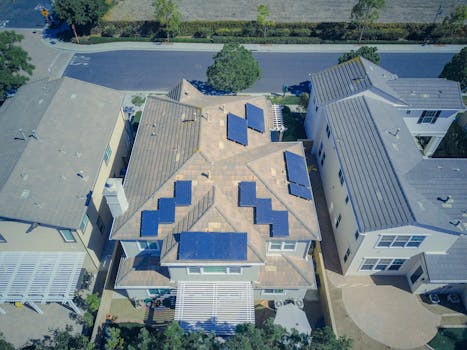“Power Your Adventure: Mastering Solar Wiring for RV Living!”
Wiring a solar system for RV living is an essential step for those seeking to harness renewable energy while on the road. This process involves understanding the components of a solar setup, including solar panels, charge controllers, batteries, and inverters. Proper wiring ensures efficient energy capture and storage, allowing RVers to enjoy the comforts of home without relying on traditional power sources. By following a systematic approach to installation and adhering to safety standards, you can create a reliable solar power system that enhances your off-grid experience.
Choosing the Right Solar Panels for Your RV
When embarking on the journey of RV living, one of the most crucial decisions you will face is choosing the right solar panels for your setup. The selection process can seem daunting, but understanding the various types of solar panels available and their respective benefits can simplify your decision. First and foremost, it is essential to consider the different types of solar panels on the market: monocrystalline, polycrystalline, and thin-film. Each type has its unique characteristics, making them suitable for different applications and preferences.
Monocrystalline panels are often regarded as the most efficient option, converting a higher percentage of sunlight into electricity. This efficiency is particularly beneficial for RV owners with limited roof space, as fewer panels may be required to meet energy needs. Additionally, monocrystalline panels tend to perform better in low-light conditions, which can be advantageous during cloudy days or when parked in shaded areas. However, it is important to note that these panels typically come at a higher price point, which may be a consideration for budget-conscious RVers.
On the other hand, polycrystalline panels are generally more affordable and are made from multiple silicon crystals. While they are slightly less efficient than their monocrystalline counterparts, they still provide a reliable source of energy for most RV applications. If you have ample roof space and are looking to save on initial costs, polycrystalline panels can be an excellent choice. Furthermore, they tend to perform well in high temperatures, making them suitable for warmer climates where many RVers often travel.
Thin-film solar panels present another option, albeit with distinct advantages and disadvantages. These panels are lightweight and flexible, making them easier to install on irregular surfaces or in tight spaces. However, they are less efficient than both monocrystalline and polycrystalline panels, which means you may need a larger surface area to generate the same amount of power. This can be a limiting factor for RV owners with restricted roof space. Nevertheless, if weight is a significant concern or if you plan to mount panels on unconventional surfaces, thin-film panels may be worth considering.
Once you have determined the type of solar panel that best suits your needs, the next step is to assess your energy requirements. Understanding how much power you consume on a daily basis is vital for selecting the appropriate number of panels and battery storage capacity. To do this, make a list of all the appliances and devices you plan to use in your RV, along with their wattage and estimated usage time. By calculating your total energy consumption, you can better gauge how many solar panels you will need to generate sufficient power.
In addition to energy needs, consider the quality and warranty of the solar panels you are contemplating. Investing in high-quality panels from reputable manufacturers can ensure longevity and reliability, which is particularly important for RV living where you may be off-grid for extended periods. A solid warranty can provide peace of mind, protecting your investment against potential defects or performance issues.
Ultimately, choosing the right solar panels for your RV involves a careful balance of efficiency, cost, and energy needs. By taking the time to research and evaluate your options, you can create a solar system that enhances your RV experience, allowing you to enjoy the freedom of the open road while harnessing the power of the sun. With the right setup, you can embark on your adventures with confidence, knowing that you have a reliable source of energy to support your lifestyle.
Understanding Solar Charge Controllers

When embarking on the journey of wiring a solar system for RV living, one of the most critical components to understand is the solar charge controller. This device plays a pivotal role in managing the energy produced by your solar panels, ensuring that your batteries are charged efficiently and safely. To grasp the importance of solar charge controllers, it is essential to first recognize their function within the broader solar power system.
At its core, a solar charge controller regulates the voltage and current coming from the solar panels to the batteries. Without this regulation, the batteries could be overcharged, leading to potential damage and a significantly reduced lifespan. Conversely, if the batteries are not charged adequately, they may not hold enough power to meet your energy needs while on the road. Therefore, selecting the right charge controller is crucial for maintaining the health of your battery bank and ensuring a reliable power supply.
There are primarily two types of solar charge controllers: PWM (Pulse Width Modulation) and MPPT (Maximum Power Point Tracking). PWM controllers are generally more affordable and simpler in design, making them a popular choice for smaller systems. They work by gradually reducing the amount of power sent to the batteries as they reach their full charge, which helps prevent overcharging. However, they are less efficient than their MPPT counterparts, especially in situations where the solar panel voltage is significantly higher than the battery voltage.
On the other hand, MPPT controllers are more sophisticated and can extract more power from the solar panels, particularly in low-light conditions or when the panels are not optimally oriented. They achieve this by adjusting the electrical operating point of the panels to maximize energy harvest. While MPPT controllers come at a higher price point, their efficiency can make them a worthwhile investment, especially for larger RV systems or those who rely heavily on solar power.
When wiring your solar system, it is essential to consider the specifications of your charge controller. Each controller has a maximum input voltage and current rating, which must not be exceeded to avoid damage. Therefore, it is advisable to calculate the total output of your solar panels and ensure that it falls within the controller’s limits. Additionally, the charge controller should be compatible with the type of batteries you are using, whether they are lead-acid, lithium, or another chemistry.
Furthermore, proper installation of the charge controller is vital for optimal performance. It should be mounted in a location that is well-ventilated and protected from the elements, as excessive heat can impair its functionality. Additionally, using appropriately sized wiring is crucial to minimize voltage drop and ensure efficient energy transfer from the solar panels to the batteries.
In conclusion, understanding solar charge controllers is fundamental for anyone looking to wire a solar system for RV living. By selecting the right type of controller, ensuring compatibility with your solar panels and batteries, and following proper installation practices, you can create a reliable and efficient solar power system. This knowledge not only enhances your RV experience but also empowers you to harness the sun’s energy effectively, allowing for greater freedom and sustainability on the open road.
Wiring Batteries for Optimal Performance
Wiring batteries for optimal performance in an RV solar system is a crucial step that can significantly enhance your off-grid experience. To begin with, understanding the types of batteries available is essential. Most RV enthusiasts opt for either lead-acid or lithium batteries, each with its own advantages and disadvantages. Lead-acid batteries are generally more affordable and widely available, but they require regular maintenance and have a shorter lifespan. On the other hand, lithium batteries, while more expensive upfront, offer longer life cycles, faster charging times, and greater efficiency, making them a popular choice for those who prioritize performance.
Once you have selected the appropriate battery type for your needs, the next step is to determine the configuration that will best suit your power requirements. Batteries can be wired in series, parallel, or a combination of both. Wiring batteries in series increases the voltage while keeping the amp-hour capacity the same, which is ideal for systems that require higher voltage, such as 24V or 48V setups. Conversely, wiring batteries in parallel maintains the voltage but increases the amp-hour capacity, allowing for longer usage times. Understanding your energy consumption and the voltage requirements of your solar system will guide you in making the right choice.
After deciding on the configuration, it is vital to use the correct gauge of wire to ensure optimal performance and safety. The wire gauge should be appropriate for the distance between the batteries and the inverter, as well as the total current that will be flowing through the system. Thicker wires are necessary for longer distances and higher currents to minimize voltage drop and heat generation. Using inadequate wire can lead to inefficiencies and potential hazards, so it is essential to consult a wire gauge chart to select the right size.
When connecting the batteries, it is important to ensure that all connections are clean and secure. Corrosion can impede performance, so using terminal protectors and regularly checking connections can help maintain optimal efficiency. Additionally, it is advisable to use high-quality connectors and terminals to ensure a reliable connection. As you wire the batteries, be mindful of the polarity; connecting them incorrectly can damage the batteries and other components in your solar system.
Furthermore, incorporating a battery management system (BMS) can greatly enhance the performance and longevity of your battery bank. A BMS monitors the state of charge, temperature, and overall health of the batteries, preventing overcharging and deep discharging, which can significantly shorten battery life. Many lithium batteries come with built-in BMS, but if you are using lead-acid batteries, consider investing in an external BMS to protect your investment.
Finally, once the batteries are wired and connected, it is crucial to regularly monitor their performance. Keeping an eye on voltage levels, state of charge, and overall health will help you identify any potential issues before they become significant problems. Regular maintenance, such as cleaning terminals and checking fluid levels in lead-acid batteries, will ensure that your system operates at peak efficiency.
In conclusion, wiring batteries for optimal performance in an RV solar system involves careful consideration of battery types, configurations, wire gauge, and connections. By following these guidelines and incorporating a battery management system, you can create a reliable and efficient power source that enhances your RV living experience, allowing you to enjoy the freedom of the open road without sacrificing comfort or convenience.
Connecting Inverters for RV Power Needs
When it comes to wiring a solar system for RV living, one of the most critical components to consider is the inverter, which converts the direct current (DC) generated by solar panels into alternating current (AC) that can power standard household appliances. Understanding how to connect inverters effectively is essential for ensuring that your RV’s power needs are met efficiently and safely. To begin with, it is important to select the right inverter for your system. Inverters come in various sizes and types, including pure sine wave and modified sine wave inverters. Pure sine wave inverters are generally recommended for RVs, as they provide cleaner power that is compatible with sensitive electronics, such as laptops and televisions.
Once you have chosen the appropriate inverter, the next step is to determine its placement within your RV. Ideally, the inverter should be located close to the battery bank to minimize voltage drop and maximize efficiency. This proximity also simplifies the wiring process, as shorter cable runs reduce the risk of power loss. After identifying the optimal location, you will need to gather the necessary materials, including appropriately sized cables, connectors, and fuses. It is crucial to use cables that can handle the current load of your inverter; typically, this means using thicker gauge wire for higher wattage inverters.
With your materials in hand, you can begin the wiring process. Start by connecting the inverter to the battery bank. This involves attaching the positive cable from the inverter to the positive terminal of the battery and the negative cable to the negative terminal. It is essential to ensure that these connections are secure and free from corrosion, as poor connections can lead to inefficiencies and potential hazards. To further protect your system, it is advisable to install a fuse or circuit breaker between the battery and the inverter. This safety measure will help prevent damage in the event of a short circuit or overload.
After establishing a secure connection to the battery, the next step is to connect the inverter to your RV’s electrical system. This typically involves running AC cables from the inverter to the RV’s distribution panel. Depending on your setup, you may choose to connect the inverter directly to the panel or use a transfer switch to alternate between shore power and inverter power. A transfer switch is particularly useful for ensuring that your appliances receive power from the correct source without the risk of backfeeding electricity into the grid.
Once all connections are made, it is crucial to test the system to ensure everything is functioning correctly. Start by turning on the inverter and checking the output voltage with a multimeter. This step will confirm that the inverter is operating within the desired range. Additionally, you should monitor the performance of your solar panels and battery bank to ensure they are adequately charging and discharging. Regular maintenance and monitoring of your solar system will help you identify any potential issues early on, allowing you to address them before they escalate.
In conclusion, connecting inverters for RV power needs is a vital aspect of setting up a solar system. By selecting the right inverter, ensuring proper placement, and following safe wiring practices, you can create a reliable power source for your RV. With careful planning and execution, you can enjoy the freedom of off-grid living while ensuring that your electrical needs are met efficiently and safely.
Q&A
1. **Question:** What components are needed to wire a solar system for RV living?
**Answer:** You need solar panels, a charge controller, batteries, an inverter, wiring, and fuses or circuit breakers.
2. **Question:** How do you connect the solar panels to the charge controller?
**Answer:** Connect the positive terminal of the solar panel to the positive input of the charge controller and the negative terminal to the negative input.
3. **Question:** How do you wire the batteries to the charge controller?
**Answer:** Connect the positive terminal of the battery to the positive output of the charge controller and the negative terminal of the battery to the negative output.
4. **Question:** How do you connect the inverter to the battery bank?
**Answer:** Connect the positive terminal of the inverter to the positive terminal of the battery and the negative terminal of the inverter to the negative terminal of the battery.
Conclusion
To wire a solar system for RV living, start by selecting the appropriate solar panels, charge controller, inverter, and batteries based on your energy needs. Install the solar panels on the roof, ensuring they are securely mounted and angled for optimal sunlight exposure. Connect the panels to the charge controller, which regulates the power going to the batteries. Wire the batteries in parallel or series, depending on your voltage requirements, and connect them to the charge controller. Finally, connect the inverter to the batteries to convert DC power to AC power for your appliances. Ensure all connections are secure and use appropriate fuses and circuit breakers for safety. Regularly monitor the system to maintain efficiency and address any issues promptly.




